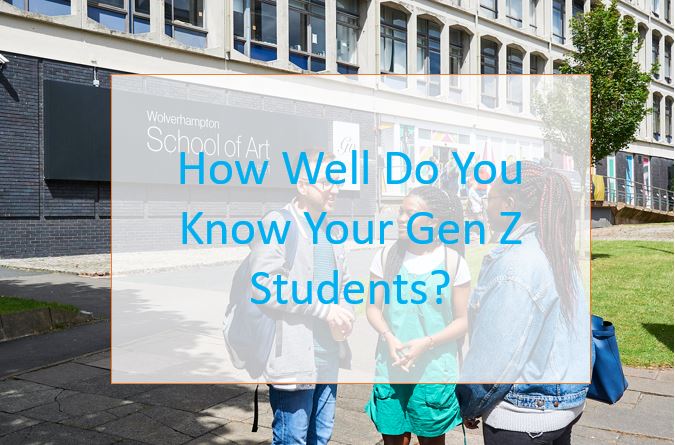Who’s the largest generation in the United States? No, it’s not Baby Boomers or Gen X or Millenials, it’s Generation Z. Born between 1995 and 2015, they now outnumber Millenials on U.S. campuses
According to Statista, Gen Z accounts for 90.55 million people or 27.7% of the U.S. population.
Of course, Gen Z is the first generation to grow up from day one with smartphones and social media, so they value and live on this technology more than their predecessors. But did you know they are also a very pragmatic, value-driven, and time-stressed group that prizes authenticity?
Their top priorities, according to Financesonline.com, include getting a job (74%), graduating from college (74%), and saving money (71%). Only 14% consider themselves big spenders. Their biggest stressors are money (81%) and work (77%). Most (67%) want authenticity from companies, defined in large part by values and beliefs aligned with their branding.
According to the National Association of College Admissions Counselors, Gen Z students are entrepreneurial and desire practical skills as part of their education. 79% would like more internship opportunities integrated into their higher ed experience. They appreciate practical, real-life experience and want to make the world a better place. 72% say they want a more customized college experience where they can design their course of study or major.
Gen Z is also the most racially and ethnically diverse generation, with 52% identifying as white, compared to 61% for millennials. 25% identify as Hispanic, 6% Asian, according to EAB.
More Gen Zers are pursuing college than previous generations, much of this jump can be attributed to an increase in Hispanics, African-Americans, and women going to college.
Steven Mintz in Inside Higher Ed says that this generation is busy and time-stressed. Also, 70% report anxiety and depression as a major issue among their peers. Sadly, Axios and others, citing a recent report by the Journal of the American Medical Association, state that the suicide rate has risen 51% for this age group over the past decade. For the older half of this generation, it is the highest it’s been since at least 1999.
What does all of this mean for colleges and universities?
Mental Health Issues
- First, of course, there is nothing more important than the health and well-being of students. On the mental health front, make sure the campus psychological counseling office is well staffed and resourced and that students are aware of the support available.
- Faculty, staff, and students should be trained to recognize the signs of students who need mental health support. The Greater Good Science Center at UC Berkeley suggests.
- Schools should incorporate this information into orientation sessions, and/or offering traditional presentations, panel discussions, role plays, short videos, student testimonials and small group discussions. Normalizing mental illness and mental health challenges are essential to destigmatizing it and making students feel comfortable in seeking help. The Center cites colleges all over the country that are launching campus-wide mental health initiatives. These efforts may include easily accessible mental health screenings, texting and phone hotlines, or professors weaving self-care and well-being practices into coursework.
- Some colleges are using an online simulation program called Kognito that helps students learn how to support friends in need. The experts tell us social isolation can fuel and worsen mental health challenges, so colleges need to make all students feel welcome and a part of the community through social events and group activities that bring students of all backgrounds together.
Money
- Clearly, one of Gen Z’s primary stressors is money, including the cost of college, and they want an education that leads to a lucrative and fulfilling career. Translation: Value in a college education is very important to them. They want a return on investment.
- Steven Mintz in Inside Higher Ed, says, “Faculty need to design curricula that address students’ career ambitions, discuss the relevance of the skills and knowledge they present, open windows into career options, and incorporate more authentic, real-world projects into their classes.”
- Being practical, short on time, and entrepreneurial, this group wants more options than the traditional professor lecturing to students in a classroom. Colleges need to expand beyond conventional educational models into such realms as experiential learning, overseas study, internships, fieldwork, practicums, hybrid classes, and online learning. Agreeing with Mintz’s point, it also helps increase value and close the gap between college and ‘real-world’ employment.
Authenticity
- On authenticity, as com puts it: GenZers “don’t want to simply purchase from your brand– they want to be part of what you stand for.” In other words, your college’s brand, to use an old cliché, should not just talk the talk but also walk the walk.
Technology
- Of course, the technology expectations are high from this “digital generation,” so don’t neglect the technology infrastructure/support and digital communications offered to this group, with special consideration given to mobile technology and social media.
As the most ethnically diverse generation, please read our last blog post on “The Changing Student Demographics in 2020,” which offers ideas and successful examples for recruiting and supporting a more diverse student body.
Finally, if are you curious to read more on this topics, see our earlier post offering helpful tips on recruiting Gen Z.
One of the many benefits of working in higher education is being around so much youthful, ambitious, creative and dreamy energy, and Gen Z has no shortage of these. Going into 2020, let’s enjoy the fun and fulfillment of working with this energetic, connected, yet grounded group that wants to change the world.






